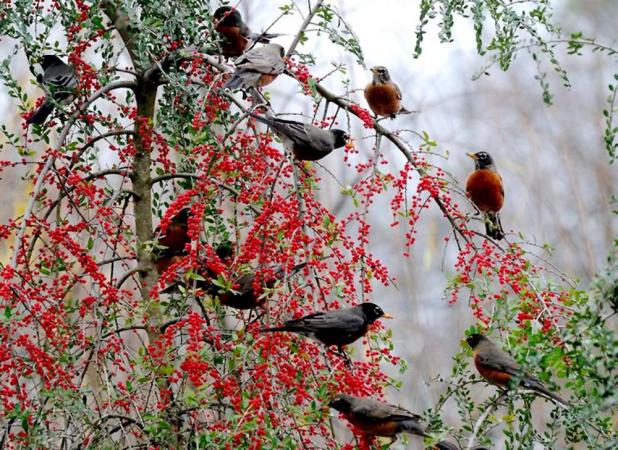
Keep wildlife and ecosystem services in mind when selecting plants.
—Norman Winter Photo
Get It Growing: A guide to plant selection
December — and winter in general — in Louisiana is a fine time to plant in the landscape. Now is the time to add trees, shrubs and cool-season annual and perennial bedding plants. The key is to know what to plant, where to plant and what is the intended use of the space.
Some things you want to avoid planting this time of year are tropical plants, warm-season annual bedding plants and turfgrasses. But that still leaves a great deal of plants to work with.
This is a great time to plant trees and shrubs. Lower temperatures and recent rainfall will help make this a much easier task.
Remove and consider replacing any trees and shrubs that died during the drought and extreme heat of the summer. For trees and shrubs that did not die but show signs of distress, we may not know the true extent of the damage for years to come. Keep an eye on them and consult a certified and licensed arborist for help with deciding on corrective actions or removal.
When selecting plants for the landscape, it’s crucial to consider various factors to ensure their successful growth and how they contribute to the overall aesthetic and functional goals of the design. Consider the purpose of your landscape — whether it’s for aesthetics, functionality such as privacy screening or specific themes.
When aesthetics is the goal, think about the color palette and texture of the plants, ensuring they complement one another and contribute to the desired visual appeal. Don’t forget about seasonal interest.
Seasonal interest in plant selection refers to the ability of plants to provide visual appeal and distinctive features throughout different seasons of the year. It involves choosing plants that offer a variety of characteristics such as flowers, foliage color, fruits or other ornamental elements that change with the seasons. The goal is to create a landscape that remains visually appealing and dynamic, even as the natural environment undergoes seasonal shifts.
Another important factor to consider is the climate. As we saw this year, we need to be selecting trees and shrubs that can tolerate extended droughts and extreme temperatures in both winter and summer.
Another important consideration is the amount of available space. Consider plant growth, both horizontally and vertically. Choose plants that fit the area and won’t overcrowd or obstruct other elements. Be sure to plant large trees an appropriate distance from the home based on their size at maturity. This cannot be stressed enough.
Consider the maintenance requirements of the plant selections. Evaluate your willingness and ability to maintain the landscape. Select plants that match your desired level of maintenance, whether low maintenance or those requiring more care.
It’s a good idea to select plants based on their disease resistance. Check plant tags or talk with retail garden center workers and the LSU AgCenter to understand what plants have improved resistance. Always consider the resistance of plants to pests and diseases to minimize the need for chemical interventions and promote overall plant health.
Be aware of any local regulations or restrictions regarding certain plant species, especially those that may be invasive or pose ecological risks. Talk with experts to understand if your plant selection may be considered an invasive species. Try to incorporate native plants, which are adapted to the local environment and support local ecosystems. However, nonnative species can also be used thoughtfully.
Don’t forget about wildlife appeal. Select plants that attract beneficial wildlife such as pollinators, birds and butterflies, contributing to a biodiverse ecosystem.
The amount of sunlight the area gets is another important consideration. Choose appropriate selections for that amount of light. Trees that bloom will bloom far less in areas of heavy shade and little sunlight. Check plant tags and be sure to match plants with their specific sunlight needs, whether they thrive in full sun, partial shade or full shade.
Other important factors are the soil type of the landscape and the watering needs of the plants. Most plants require good drainage; others can tolerate low spots that hold water. Choose accordingly. Also, if you do not plan to irrigate when rain is scarce, make sure you choose plants that are drought tolerant.
